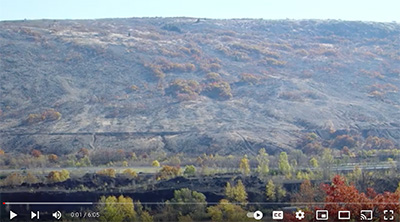
The Lehigh Gap Nature Center lies on a restored section of a U.S. Superfund site. Over the years, Moravian University students have helped to monitor and maintain the health of this land, its plants, and animals.
Visit the 756-acre wildlife refuge at the Lehigh Gap Nature Center (LGNC), and you’d find it hard to believe that 400 of those acres, more than half, once lay barren, earning it the descriptor “moonscape”—the result of more than eight decades of exposure to toxic emissions from a zinc factory. Today it is a grassland rich with hundreds of species of plants and animals.
Since 2007, Moravian students under the guidance of Diane Husic, dean of the Center for Scholarship, Research, and Creative Endeavors, and the late Frank Kuserk, professor of biology, have been analyzing plants for the uptake of toxic metals and monitoring the return of biodiversity.

For 85 years, beginning in 1898, a zinc smelting plant near the Lehigh Gap emitted sulfur dioxide and heavy metals, including zinc, cadmium, and lead, causing an avalanche of environmental degradation. As Husic explains, sulfur dioxide reacts in the atmosphere to form sulfuric acid and acid rain, which likely killed most of the vegetation across roughly 3,000 acres on the Kittatinny Ridge. The heavy metals contaminated the soil, preventing new seedlings from surviving. Without vegetation holding it in place, the topsoil eroded off the mountain, carrying its metal contaminants—toxic to most organisms—into the Lehigh River. In 1983, the Environmental Protection Agency (EPA) designated these 3,000 acres a Superfund site.
A Superfund site is a federally designated toxic waste site. These sites are among the most contaminated in the country and present a significant health risk to wildlife and humans. The Palmerton Zinc Pile Superfund Site is the largest east of the Mississippi.
Many efforts to revegetate the mountainside did not work, says Husic. The Lehigh Gap Nature Center, a nonprofit conservation organization, purchased 400 acres of the Superfund site and looked to nature to find solutions for revegetating the land. They learned that the soil in the Serpentine Barrens in southeastern Pennsylvania is high in metals, and native prairie grasses grow there, so they decided to follow this model at the Lehigh Gap. “These grass species don’t take up the heavy metals; rather they sequester them in the ground,” Husic says. “And they help to stabilize erosion and allow for habitat for other species to repopulate the area.”
In 2003, 56 one-acre test plots were established to determine which combination of grass seed and soil amendments would be most successful. Husic first became involved in 2005, and two years later, Moravian students began to work at the site. “Our students contributed to research determining which plants that were part of the revegetation efforts were taking up the metal pollutants, as that is problematic. Meredith Wright ’10 researched and wrote an extensive annotated bibliography of the Palmerton Zinc Pile Superfund site and Lehigh Gap, which was a major contribution.”
Some of Kuserk’s students did research to understand the soil microbes. Others monitored the turtle populations at the ponds, and one did catch-and-release studies to learn which small mammals were returning.
“Over the years, several students have contributed to monitoring the return of biodiversity at the site and discussing adaptive management strategies for the Lehigh Gap Nature Center land,” Husic says. “They have worked with the EPA, independent consultants who are experts in ecological restoration, and the Lehigh Gap Nature Center staff.”
One of those students was Laura McBride ’16. She completed two summer SOAR projects and honors research at LGNC. She created an annotated bibliography of sources that pertain to the Kittatinny Ridge and analyzed zinc contamination in plants at the restored site. “I collected flowering plants that had been growing on the property after several years of remediation to determine how much zinc these plants were taking up from the contaminated soil, using instrumentation and Flame Atomic Absorption Spectroscopy in the chemistry labs at Moravian,” says McBride. “My results showed that many of the flowering plants were taking up zinc from the soil, with some species containing higher levels of zinc than others. This is problematic because it means the contamination is moving through the ecosystem instead of staying contained in the soil.
“Working on research projects at the LGNC helped me discover my passion for the environment and the intersection of chemistry and the environment,” adds McBride, who is an assistant professor of chemistry and biochemistry at Albright College and teaches courses in chemistry and climate change.
Janniry Cabrera Belen ’21 also found her experience at LGNC defining. During her two years working there while an undergrad, she created bilingual educational tools, such as YouTube videos, for Lehigh Valley students, and she contributed to educational resources at the nature center, including bilingual trail signs, a booklet about native plants, and a demonstration garden showcasing the restoration. “The time I spent at the LGNC was one of the most rewarding experiences of my academic and professional career,” Belen says, “so much so that I decided to pursue a PhD in ecology [at Penn State University] with a focus on restoration techniques. I want to continue aiding in improving our green spaces and advance restoration techniques like what was done at the LGNC.”
The Lehigh Gap Nature Center is the only public environmental education center and wildlife refuge in the country that has been built on part of a Superfund site. Featuring native grasslands, ponds, forested slopes, cliffs, and a 2.5-mile riparian zone, it is an “earthscape,”—a land recovered and protected by a community of citizens, scientists, and students.